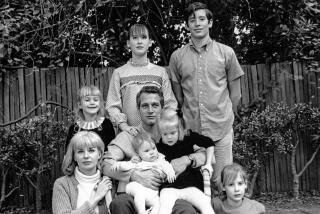Trout savant in a big black cape
In ALL OF TROUT LITERATURE, THERE MAY BE NO VOLUME more often prescribed, or more likely to be mistaken for a comic book, than a 28-year-old wonder called “The Curtis Creek Manifesto.” But this book’s admirers -- hundreds of thousands of them -- have never been too clear about the man behind the manifesto.
He claimed four names. He favored black hats and a flowing cape and considered himself “one of the last Edwardians.” He died 20 years ago at age 47, leaving only the most cryptic biographical clues in his work. But in certain circles, Sheridan Andreas Mulholland Anderson is still remembered clearly.
“He was an artist, you know? He didn’t do anything halfway,” says Yvon Chouinard, sportsman and founder of Patagonia sportswear, who met Anderson at Yosemite in the 1960s and climbed and fished with him. “ ‘The Curtis Creek Manifesto,’ ” says Chouinard, “is probably the best beginner’s treatise on how to fly-fish. It’s all sensible stuff.”
The author’s big break came nearly 30 years ago, when Frank Amato of Portland, Ore., publisher of fishing books, found an odd manuscript in his in box. Clever drawings. Sound fly-fishing advice. San Francisco address.
Amato bit. First he called the author, then he flew south to firm up a deal.
“He picked me up at the airport,” Amato remembers. “He seemed to me to be a perfect ringer for Long John Silver. Dark hair, 6-2 or so. Full chest. And he had kind of a challenging air about him.”
Conceived as “a fully illustrated guide to the strategy, finesse, tactics and paraphernalia of fly-fishing,” Mr. Anderson’s opus covers 48 pages, providing at last the missing link between Izaak Walton’s 17th century angling wisdom and R. Crumb’s high-stepping “Keep on Truckin’ ” man.
Looking like a Renaissance Faire bouncer, the author stares out at readers from an opening page, mustache bristling, hair tousled, perhaps from jousting. His chin rests on a hand and the eyes blaze in ferocious thought. “Angler, artist, wander, eternal foe of the work ethic,” says the caption.
Googling will tell you that the manifesto stands about 54,000th on Amazon’s sales chart and that Anderson is also credited as the illustrator and co-author, years back, on a handful of rock-climbing and camping books, including a couple written by celebrated climber Royal Robbins. As for the man behind the pen, “he was big. Probably close to 300 pounds.... Always dressed in black, and had that black hat and big black cape,” recalls Amato’s sister, Lorraine Guelker.
“He came to our home once,” says Amato. “My wife was cooking two roasts, with the idea that we would have one the next day. I brought out a bottle of Scotch. He pretty much put away the whole bottle before dinner. And then he polished off one of the pork roasts. Voracious appetites.”
On that same visit, Amato remembers, Anderson decided to check out a creek near the house. When Amato looked out, he saw the big man on his hands and knees, crawling toward the water’s edge.
“The book,” says Amato, “is really, exactly him.”
Anderson was a stealth man. In the manifesto, he warns against letting your shadow fall on water, casting sloppily, walking heavily, standing tall -- anything that might scare fish. When fly-fishing is done right, he writes, “the water becomes a glorious, shimmering three-dimensional chessboard” and the contest is “a game to be mastered thru skill, diligence and imagination.”
As for the location of the beloved body of water in the title, “that is your final lesson: to go forth and seek your own Curtis Creek.... There are few Curtis Creeks in this life so when you find it, keep its secret well....”
Michael Anderson, 62 and retired in Fullerton, says his older brother spent most of his youth around Salt Lake City, tying flies, keeping pigeons, reading, keeping an asthma inhaler handy, drawing, painting and fishing like a fiend. With a favorite uncle, he learned fly-fishing on the West Yellowstone, the Snake and the Madison in Montana, among others.
Later, Michael Anderson remembers his big brother dropping out of the University of Utah, hanging out at Camp Four in Yosemite, tending to their grandmother in Las Vegas and composing haughty notes to editors who dared to reject him. Before he mailed envelopes, Anderson would scrawl messages taunting the postal service. “If you were to look into whatever the FBI was doing in the ‘70s, they’d probably have a file on him,” says Amato.
Twice-divorced and childless, the author seemed to live on book royalties, guiding the occasional Sierra fishing expedition. Eventually he bought a cabin in Chiloquin, Ore. He was visiting his grandmother when he died. Emphysema and asthma were blamed, but friends and family suspect the drinking abetted. His ashes landed in the Sierra’s Golden Trout Wilderness.
“Sheridan’s personal life was not such that one could recommend it to youth,” reads Michael Anderson aloud from a tribute written by Royal Robbins. “Sheridan had a double talent: the ability to read character, and the skill to render it with precise satirical strokes.... Like most of us, he was caught in the mud and yearned for the sky.” Then there’s a pause.
“I’m starting to choke up,” says Michael Anderson.
These days the Amato Publications catalog includes 300 titles, but the manifesto is still the top seller every year, in all nearly 300,000 copies.
Now, about the Oregon dateline above. In this life, as the author says, we must each find our own Curtis Creek. But I happened to be passing near Sheridan Anderson’s old territory recently, and I couldn’t resist stopping just outside Chiloquin, where the Williamson River meets Spring Creek.
In his mind’s eye, Frank Amato had told me, he’d always pictured the big guy out on the Williamson, watching the trout rise. I parked in an empty lot and crept to the water’s edge, listening to the current burble past a fallen pine. There wasn’t another man or woman in sight. But that doesn’t mean I was alone. Even with that cape, Sheridan Anderson was always a stealth man.
To e-mail Christopher Reynolds or to read his previous Wild West columns, go to latimes.com/chrisreynolds.
More to Read
Sign up for our Book Club newsletter
Get the latest news, events and more from the Los Angeles Times Book Club, and help us get L.A. reading and talking.
You may occasionally receive promotional content from the Los Angeles Times.







